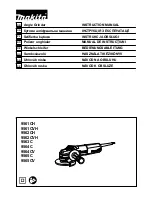
.
57.
a. With the wing bolted in place on the fuselage, trial fit the stabilizer/fin assembly. The stabilizer should sit against the
back of the wing with no gap. If the stabilizer seems tilted slightly, you should trim the top of one of the fuselage
sides until the stabilizer sits level with the wing.
b. When satisfied with the alignment, draw cut lines on the bottom of the stabilizer at the fuselage sides. Remove the
stabilizer and use a sharp knife to cut away the covering on the bottom where it will be glued to the fuselage.
58.
a. Hold the stabilizer/fin assembly in place on the fuselage, then glue it firmly with CA working through the hatch
opening.
b. Install the nylon control horn on the elevator so that it's centered in the opening at the back of the fuselage. Use two
#2x1/2" sheet metal screws to install the horn, then clip or grind off the pointy ends of the screws.
59.
Cut out the canopy of your choice from the printed 1/4" balsa sheet, again leaving the entire black line on the parts. Match
the bottom edge of the canopy to your wing by taping sandpaper to the wing's upper surface and gently pushing the canopy
from side to side.
60.
If you chose the one-piece Angel canopy, go ahead and round off the upper edge, cover it, and glue it to the top of the wing
(after removing a strip of covering material to provide a wood-to-wood joint, of course). The other Wonder versions feature a
two-piece canopy with the front portion glued to the wing and the rear portion glued to the stabilizer. Temporarily pin the
canopy parts in their proper position on the assembled model, then attach the front and rear canopy parts to each other with
a piece of tape on each side. Now the canopy parts can be lifted from the model and their top edges sanded round at the
same time so they will match perfectly when installed. Remove the tape, cover the canopy parts, and glue them in place.
61.
Install your fuel tank, engine and muffler. The easiest way to install the fuel tank (which was prepared in step 40) is to run
extra-long fuel lines through F-1, attach them to the tank, then slide the tank into place while gently pulling the fuel lines
back through F-1. Now you can bolt your engine mounts to F-1, bolt your engine to the mounts, bolt the muffler to your
engine, and cut the fuel lines to their final length. The propeller should be mounted so that it's level with the wing when it
comes up against the engine compression, to minimize the chance of breaking it during landings. Attach your spinner cone
and the engine installation is complete.
62.
Glue the skid to the bottom of the fuselage.
RADIO INSTALLATION
Different radio installations using different size servos and receivers are described under specific versions of the Wonder
following. One thing that's common to all of them is that they're stuffed into one tight little fuselage! Every radio installation is
unique and must be planned carefully to make certain that the servo arms and control linkages have clear room to operate.
The following guidelines are meant to provide general information on stuffing a Wonder with radio gear.









































